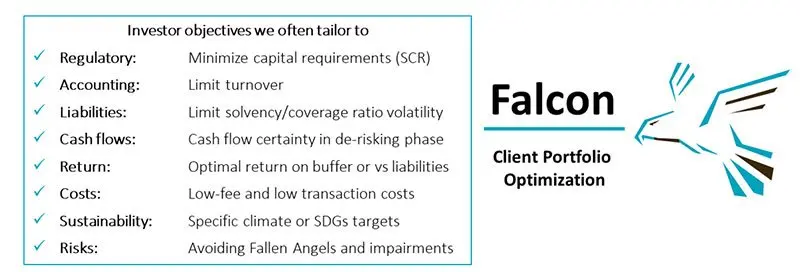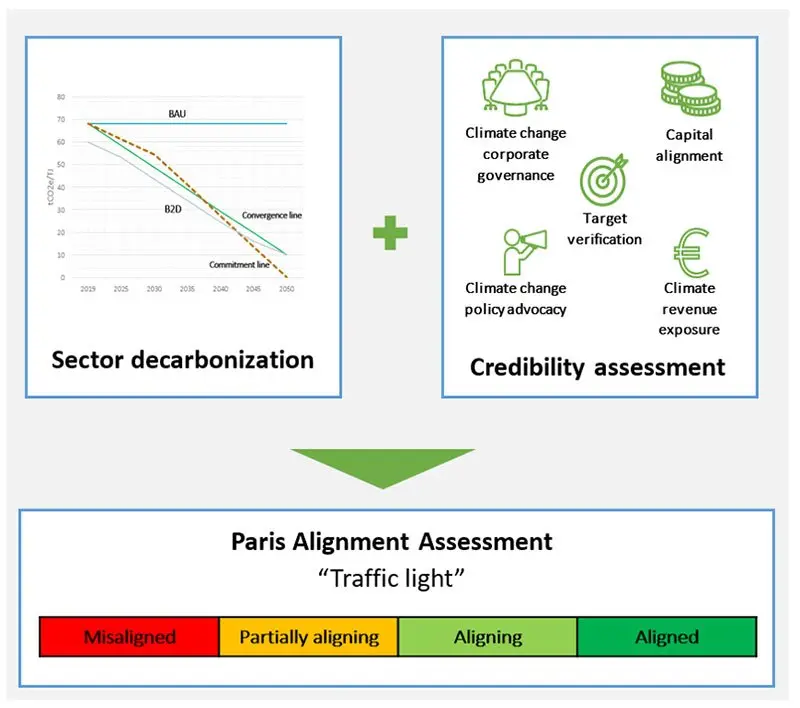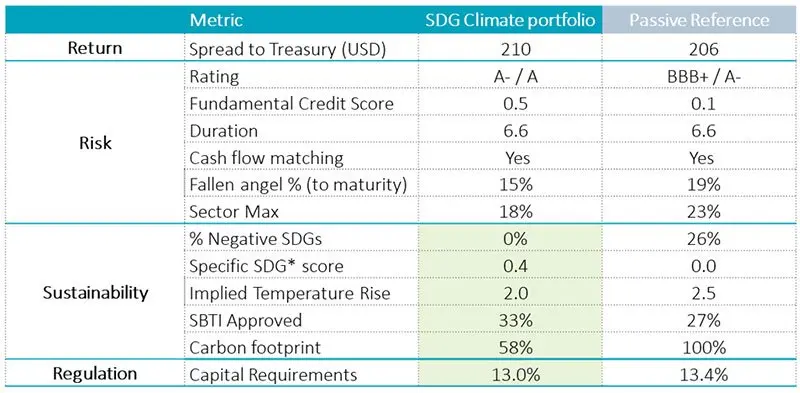Insurers and pension funds face the imperative of finding investment solutions that generate sufficient returns while also managing risk, in a world of high inflation, geopolitical uncertainty and increasing regulation. The focus on sustainability and specifically climate change is also rising, with increasing pressure to set net-zero commitments.
Setting and implementing climate targets are the next steps in this challenge. Targets typically include emission reductions, engagement and investment in climate solutions, with the ultimate aim of reducing real-world emissions and enabling the transition to a low-carbon economy. Implementing these targets requires forward-looking climate analytics that go beyond traditional carbon footprint data and that can be applied to anticipate future emission pathways.
We consider the most effective metrics for building Paris-aligned portfolios and illustrate how they can be used in conjunction with other portfolio metrics to construct buy-and-maintain and constrained credit portfolios.
Climate portfolio optimization challenge
For insurers and pension funds, the challenge is to balance the economic and regulatory profile of the portfolio with restrictions and objectives that are driven by sustainability. Figure 1 shows an overview of the objectives on which we typically optimize portfolios using our proprietary Fixed income Asset & Liability Client Optimization Navigation (FALCON) tooling.
Figure 1 | Typical investor objectives

Source: Robeco. For illustrative purposes only.
When it comes to aligning a portfolio with a net-zero 2050 ambition, an important aspect to consider is the forward-looking portfolio profile of the carbon footprint. Forward-looking climate analytics play an important part in this.
Forward-looking climate analytics
There are different ways of estimating and assessing the future pathway of emissions for a company. We discuss four metrics that we use for this assessment: two proprietary in-house metrics and two external metrics.
1. The Robeco Paris Alignment Assessment (‘Traffic Light’)
The Robeco Traffic Light assesses a company’s degree of alignment with a below 2 °C scenario. The categories of alignment can vary from ‘aligned’, ‘aligning’ and ‘partially aligning’ to ‘misaligned’ (see Figure 2). Our SI research analysts assess a company’s degree of alignment by determining the following:
Are this company’s projected emissions in line with its required sector decarbonization pathway?
Does the company have verified targets and a credible plan for achieving its emission-reduction plans?
Figure 2 | Robeco Paris Alignment assessment

Source: Robeco. For illustrative purposes only.
We use the Paris Alignment assessment for three main purposes: engagement, voting and portfolio construction. While this is our preferred method for assessing the future trajectory of portfolio emissions, external metrics can also be used to assess alignment. Two such metrics are Science Based Targets initiative approval and Implied Temperature Rise.
2. Robeco Climate Risk Assessment
The Traffic Light is also an important input in our fundamental assessment to determine to what extent climate risk could have an impact on a firm’s business fundamentals. This climate risk assessment by our fundamental credit analysts of a company’s credit risk profile has three components: assess the level of climate risk exposure, establish how the firm is dealing with climate risk, and estimate the potential financial impact. It incorporates internal and external metrics. We see this as the most complete assessment of a company’s exposure to climate change and the potential impact on default and downgrade risk.
3. Science Based Targets initiative (SBTi)
The SBTi was created in 2015, following the Paris Agreement, to measure the robustness of companies’ targets relative to the ambition of the Paris Agreement. To do this, the SBTi created sectoral methodologies to determine the required reduction in emissions per sector and to establish which metrics are most relevant. The SBTi assesses whether the trajectories of companies are aligned with different pathways. The main advantages of this metric are that it is simple, has a transparent methodology and is widely used and scrutinized. One of the drawbacks is that it can not confirm the likelihood of a company’s ability to meet its targets.
4. Implied Temperature Rise
Implied Temperature Rise (ITR) metrics reflect an implied global temperature rise that is calculated using a company’s emissions overshoot or undershoot relative to a given carbon budget. It is an intuitive metric that, by making a number of assumptions, data providers are usually able to achieve high coverage of the investment universe. However, the modeling entails significant complexity and various assumptions, which can result in a wide range of possible portfolios and outcomes. And, as is the case with the SBTi, most providers rely on the targets set by companies and do not include any assessment of the credibility of these targets.
There is overlap between these four metrics and each has advantages and disadvantages, ranging from issuer coverage and data quality, to comprehensiveness of assessment. In our view, the metrics are best used in combination, with our fundamental assessments of climate alignment and risk being an overriding factor for issuer selection.
Case study: Balancing climate integration with risk, return and regulatory considerations
We illustrate our approach to incorporating climate targets using a cash flow-matching case study that is a typical for many life insurers or when de-risking a pension scheme. The portfolio in this case study needs to limit the number of fallen angels, match the target cash flow, uphold a minimum rating, have an optimal spread, maintain low capital requirements, make an impact across the SDGs and limit the current and future carbon footprint.
After in-depth client consultation, we construct a portfolio that balances the client’s various risk, return, regulatory and sustainability criteria, and we show across a range of metrics how this portfolio measures up versus a passive reference, as illustrated in Figure 3.
Figure 3 | Case study portfolio characteristics

Source: Robeco, Trucost, SBTI, MSCI, Bloomberg and using September 2022 valuations. For illustrative purposes only and based on model assumptions. Fundamental score ranges between -3, +3 and reflect Robeco’s credit analysts’ assessment of the credit quality. SDG score ranges between -3, +3 and reflects Robeco’s SI analysts’ assessment of the SDG alignment. Carbon footprint is scope 1,2 & 3 and indexed to passive reference. The Fallen Angel % uses average historical rating migration numbers. *refers to the portfolio score on the most climate-related SDGs: 7. Affordable and Clean Energy, 11. Sustainable Cities and Communities and 13. Climate Action.
The SDGs can be used to further generate a targeted impact on specific investors’ sustainability objectives through alignment with a specific set of the UN SDGs. Also, by allocating solely to companies that score positively on the SDGs, an SFDR article 9 portfolio can be created.
重要事項
当資料は情報提供を目的として、Robeco Institutional Asset Management B.V.が作成した英文資料、もしくはその英文資料をロベコ・ジャパン株式会社が翻訳したものです。資料中の個別の金融商品の売買の勧誘や推奨等を目的とするものではありません。記載された情報は十分信頼できるものであると考えておりますが、その正確性、完全性を保証するものではありません。意見や見通しはあくまで作成日における弊社の判断に基づくものであり、今後予告なしに変更されることがあります。運用状況、市場動向、意見等は、過去の一時点あるいは過去の一定期間についてのものであり、過去の実績は将来の運用成果を保証または示唆するものではありません。また、記載された投資方針・戦略等は全ての投資家の皆様に適合するとは限りません。当資料は法律、税務、会計面での助言の提供を意図するものではありません。 ご契約に際しては、必要に応じ専門家にご相談の上、最終的なご判断はお客様ご自身でなさるようお願い致します。 運用を行う資産の評価額は、組入有価証券等の価格、金融市場の相場や金利等の変動、及び組入有価証券の発行体の財務状況による信用力等の影響を受けて変動します。また、外貨建資産に投資する場合は為替変動の影響も受けます。運用によって生じた損益は、全て投資家の皆様に帰属します。したがって投資元本や一定の運用成果が保証されているものではなく、投資元本を上回る損失を被ることがあります。弊社が行う金融商品取引業に係る手数料または報酬は、締結される契約の種類や契約資産額により異なるため、当資料において記載せず別途ご提示させて頂く場合があります。具体的な手数料または報酬の金額・計算方法につきましては弊社担当者へお問合せください。 当資料及び記載されている情報、商品に関する権利は弊社に帰属します。したがって、弊社の書面による同意なくしてその全部もしくは一部を複製またはその他の方法で配布することはご遠慮ください。 商号等: ロベコ・ジャパン株式会社 金融商品取引業者 関東財務局長(金商)第2780号 加入協会: 一般社団法人 日本投資顧問業協会


